KIA OPTIMA 2017 Owners Manual
Manufacturer: KIA, Model Year: 2017, Model line: OPTIMA, Model: KIA OPTIMA 2017Pages: 629, PDF Size: 15.24 MB
Page 601 of 629
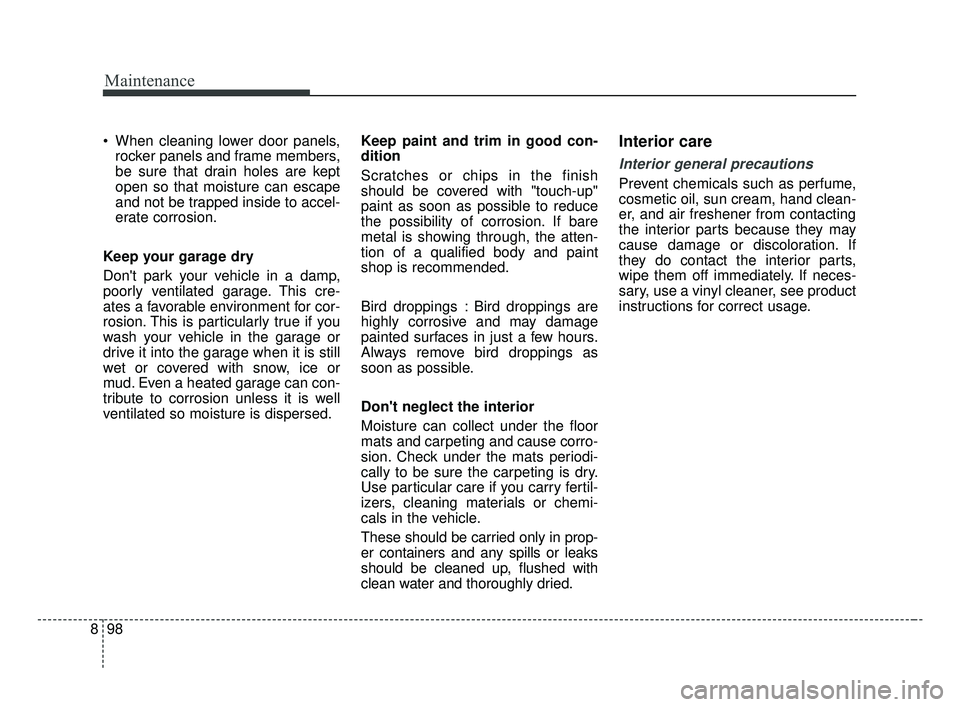
Maintenance
98
8
When cleaning lower door panels,
rocker panels and frame members,
be sure that drain holes are kept
open so that moisture can escape
and not be trapped inside to accel-
erate corrosion.
Keep your garage dry
Don't park your vehicle in a damp,
poorly ventilated garage. This cre-
ates a favorable environment for cor-
rosion. This is particularly true if you
wash your vehicle in the garage or
drive it into the garage when it is still
wet or covered with snow, ice or
mud. Even a heated garage can con-
tribute to corrosion unless it is well
ventilated so moisture is dispersed. Keep paint and trim in good con-
dition
Scratches or chips in the finish
should be covered with "touch-up"
paint as soon as possible to reduce
the possibility of corrosion. If bare
metal is showing through, the atten-
tion of a qualified body and paint
shop is recommended.
Bird droppings : Bird droppings are
highly corrosive and may damage
painted surfaces in just a few hours.
Always remove bird droppings as
soon as possible.
Don't neglect the interior
Moisture can collect under the floor
mats and carpeting and cause corro-
sion. Check under the mats periodi-
cally to be sure the carpeting is dry.
Use particular care if you carry fertil-
izers, cleaning materials or chemi-
cals in the vehicle.
These should be carried only in prop-
er containers and any spills or leaks
should be cleaned up, flushed with
clean water and thoroughly dried.Interior care
Interior general precautions
Prevent chemicals such as perfume,
cosmetic oil, sun cream, hand clean-
er, and air freshener from contacting
the interior parts because they may
cause damage or discoloration. If
they do contact the interior parts,
wipe them off immediately. If neces-
sary, use a vinyl cleaner, see product
instructions for correct usage.
JF CAN (ENG) 8.qxp 2016-09-23 10:25 Page 98
Page 602 of 629
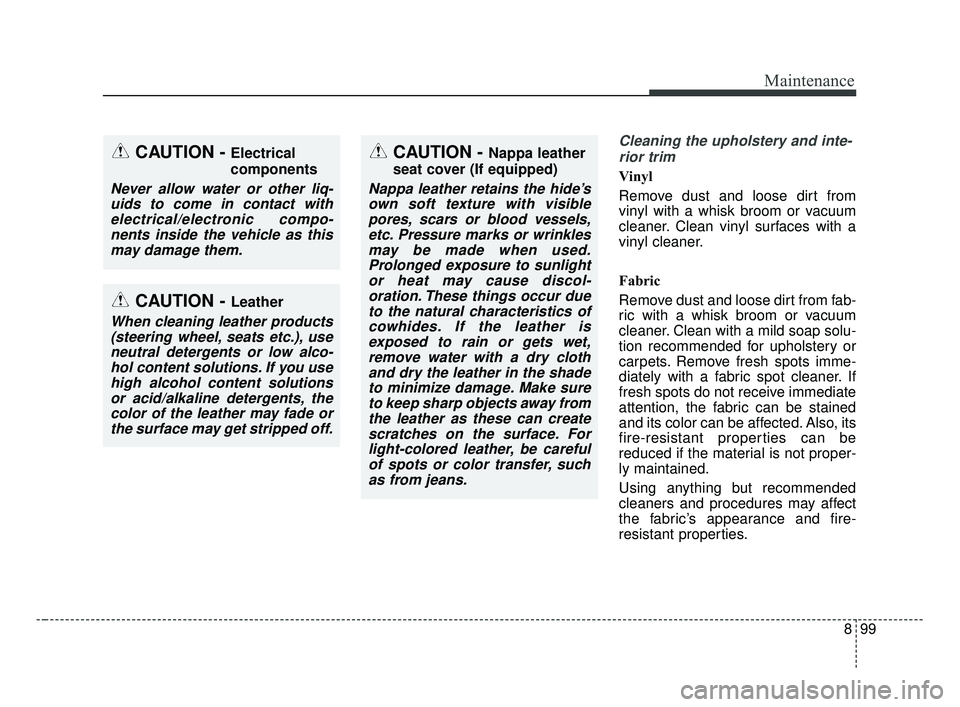
899
Maintenance
Cleaning the upholstery and inte-rior trim
Vinyl
Remove dust and loose dirt from
vinyl with a whisk broom or vacuum
cleaner. Clean vinyl surfaces with a
vinyl cleaner.
Fabric
Remove dust and loose dirt from fab-
ric with a whisk broom or vacuum
cleaner. Clean with a mild soap solu-
tion recommended for upholstery or
carpets. Remove fresh spots imme-
diately with a fabric spot cleaner. If
fresh spots do not receive immediate
attention, the fabric can be stained
and its color can be affected. Also, its
fire-resistant properties can be
reduced if the material is not proper-
ly maintained.
Using anything but recommended
cleaners and procedures may affect
the fabric’s appearance and fire-
resistant properties.
CAUTION - Electrical
components
Never allow water or other liq-uids to come in contact withelectrical/electronic compo-nents inside the vehicle as thismay damage them.
CAUTION - Nappa leather
seat cover (If equipped)
Nappa leather retains the hide’s own soft texture with visiblepores, scars or blood vessels,etc. Pressure marks or wrinklesmay be made when used.Prolonged exposure to sunlightor heat may cause discol-oration. These things occur dueto the natural characteristics ofcowhides. If the leather isexposed to rain or gets wet,remove water with a dry clothand dry the leather in the shadeto minimize damage. Make sureto keep sharp objects away fromthe leather as these can createscratches on the surface. Forlight-colored leather, be carefulof spots or color transfer, suchas from jeans.
CAUTION - Leather
When cleaning leather products(steering wheel, seats etc.), useneutral detergents or low alco-hol content solutions. If you usehigh alcohol content solutionsor acid/alkaline detergents, thecolor of the leather may fade orthe surface may get stripped off.
JF CAN (ENG) 8.qxp 2016-09-23 10:25 Page 99
Page 603 of 629

Maintenance
100
8
Cleaning the lap/shoulder belt
webbing
Clean the belt webbing with any mild
soap solution recommended for
cleaning upholstery or carpet. Follow
the instructions provided with the
soap. Do not bleach or re-dye the
webbing because this may weaken it.
Cleaning the interior window glass
If the interior glass surfaces of the
vehicle become fogged (that is, cov-
ered with an oily, greasy or waxy
film), they should be cleaned with a
glass cleaner. Follow the directions
on the glass cleaner container.
Leather seat cover using precau-tions (If equipped)
Natural leather has visible pores,
scars or blood vessels, etc. Pressure
marks or wrinkles may be made
when used. Prolonged exposure to
sunlight or heat may cause discol-
oration. These things occur due to the
natural characteristics of cowhides. If
the leather is exposed to rain or gets
wet, remove water with a dry cloth
and dry the leather in the shade to
minimize damage. Make sure to keep
sharp objects away from the leather
as these can create scratches on the
surface. For light-colored leather, be
careful of spots or color transfer, such
as from jeans.
Fabric seat cover using precau-tions (if equipped)
Please clean the fabric seats regular-
ly with a vacuum cleaner in consider-
ation of fabric material characteristics.
If they are heavily soiled with bever-
age stains, etc., use a suitable interior
cleaner. To prevent damage to seat
covers, wipe off the seat covers down
to the seams with a large wiping
motion and moderate pressure using
a soft sponge or microfiber cloth.
Velcro closures on clothing or sharp
objects may cause snagging or
scratches on the surface of the seats.
Make sure not to rub such objects
against the surface.
CAUTION- Rear window
Do not scrape or scratch theinside of the rear window. Thismay result in damage of the rearwindow defroster grid.
JF CAN (ENG) 8.qxp 2016-09-23 10:25 Page 100
Page 604 of 629
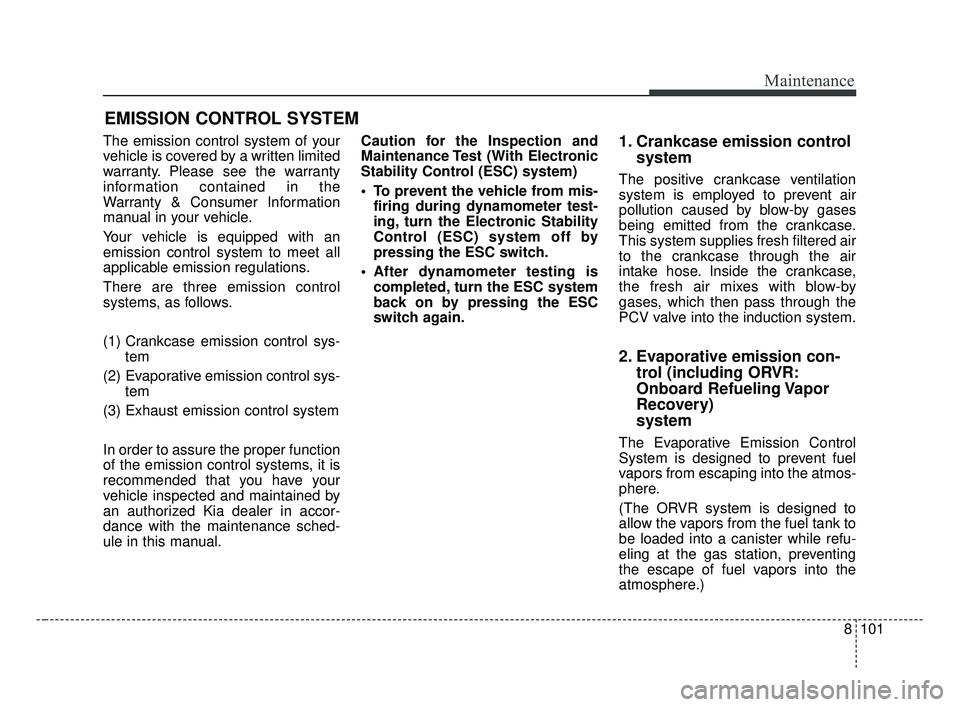
8101
Maintenance
EMISSION CONTROL SYSTEM
The emission control system of your
vehicle is covered by a written limited
warranty. Please see the warranty
information contained in the
Warranty & Consumer Information
manual in your vehicle.
Your vehicle is equipped with an
emission control system to meet all
applicable emission regulations.
There are three emission control
systems, as follows.
(1) Crankcase emission control sys-tem
(2) Evaporative emission control sys- tem
(3) Exhaust emission control system
In order to assure the proper function
of the emission control systems, it is
recommended that you have your
vehicle inspected and maintained by
an authorized Kia dealer in accor-
dance with the maintenance sched-
ule in this manual. Caution for the Inspection and
Maintenance Test (With Electronic
Stability Control (ESC) system)
To prevent the vehicle from mis-
firing during dynamometer test-
ing, turn the Electronic Stability
Control (ESC) system off by
pressing the ESC switch.
After dynamometer testing is completed, turn the ESC system
back on by pressing the ESC
switch again.1. Crankcase emission control system
The positive crankcase ventilation
system is employed to prevent air
pollution caused by blow-by gases
being emitted from the crankcase.
This system supplies fresh filtered air
to the crankcase through the air
intake hose. Inside the crankcase,
the fresh air mixes with blow-by
gases, which then pass through the
PCV valve into the induction system.
2. Evaporative emission con-trol (including ORVR:
Onboard Refueling Vapor
Recovery)
system
The Evaporative Emission Control
System is designed to prevent fuel
vapors from escaping into the atmos-
phere.
(The ORVR system is designed to
allow the vapors from the fuel tank to
be loaded into a canister while refu-
eling at the gas station, preventing
the escape of fuel vapors into the
atmosphere.)
JF CAN (ENG) 8.qxp 2016-09-23 10:25 Page 101
Page 605 of 629
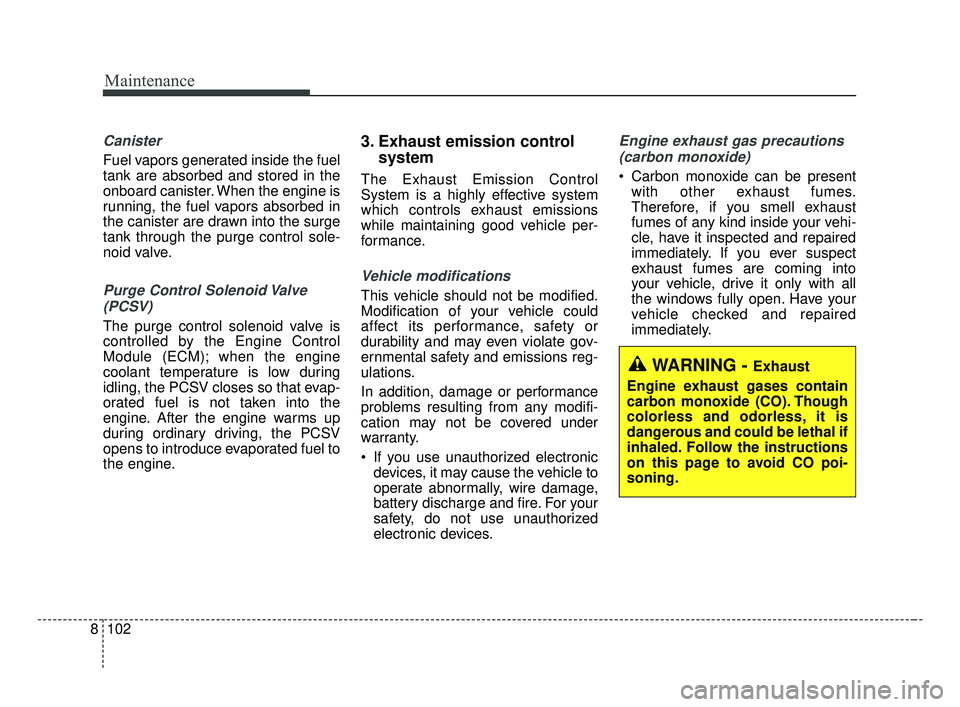
Maintenance
102
8
Canister
Fuel vapors generated inside the fuel
tank are absorbed and stored in the
onboard canister. When the engine is
running, the fuel vapors absorbed in
the canister are drawn into the surge
tank through the purge control sole-
noid valve.
Purge Control Solenoid Valve
(PCSV)
The purge control solenoid valve is
controlled by the Engine Control
Module (ECM); when the engine
coolant temperature is low during
idling, the PCSV closes so that evap-
orated fuel is not taken into the
engine. After the engine warms up
during ordinary driving, the PCSV
opens to introduce evaporated fuel to
the engine.
3. Exhaust emission control system
The Exhaust Emission Control
System is a highly effective system
which controls exhaust emissions
while maintaining good vehicle per-
formance.
Vehicle modifications
This vehicle should not be modified.
Modification of your vehicle could
affect its performance, safety or
durability and may even violate gov-
ernmental safety and emissions reg-
ulations.
In addition, damage or performance
problems resulting from any modifi-
cation may not be covered under
warranty.
If you use unauthorized electronic
devices, it may cause the vehicle to
operate abnormally, wire damage,
battery discharge and fire. For your
safety, do not use unauthorized
electronic devices.
Engine exhaust gas precautions
(carbon monoxide)
Carbon monoxide can be present with other exhaust fumes.
Therefore, if you smell exhaust
fumes of any kind inside your vehi-
cle, have it inspected and repaired
immediately. If you ever suspect
exhaust fumes are coming into
your vehicle, drive it only with all
the windows fully open. Have your
vehicle checked and repaired
immediately.
WARNING - Exhaust
Engine exhaust gases contain
carbon monoxide (CO). Though
colorless and odorless, it is
dangerous and could be lethal if
inhaled. Follow the instructions
on this page to avoid CO poi-
soning.
JF CAN (ENG) 8.qxp 2016-09-23 10:25 Page 102
Page 606 of 629

8103
Maintenance
Do not operate the engine in con-fined or closed areas (such as
garages) any more than what is
necessary to move the vehicle in or
out of the area.
When the vehicle is stopped in an open area for more than a short
time with the engine running,
adjust the ventilation system (as
needed) to draw outside air into the
vehicle.
Never sit in a parked or stopped vehicle for any extended time with
the engine running.
When the engine stalls or fails to start, excessive attempts to restart
the engine may cause damage to
the emission control system.Operating precautions for catalyt-
ic converters (if equipped)
WARNING- Catalytic converter
Keep away from the catalytic
converter and exhaust system
while the vehicle is running or
immediately thereafter. The
exhaust and catalytic systems
are very hot and may burn you.
WARNING- Fire
Do not park, idle or drive the vehicle over or near flamma-
ble objects, such as grass,
vegetation, paper, leaves, etc.
A hot exhaust system can
ignite flammable items under
your vehicle.
Also, do not remove the heat sink around the exhaust sys-
tem, do not seal the bottom of
the vehicle or do not coat the
vehicle for corrosion control.
It may present a fire risk under
certain conditions.
JF CAN (ENG) 8.qxp 2016-09-23 10:26 Page 103
Page 607 of 629

Maintenance
104
8
Your vehicle is equipped with a cat-
alytic converter emission control
device.
Therefore, the following precautions
must be observed:
Use only UNLEADED FUEL for
gasoline engines.
Do not operate the vehicle when there are signs of engine malfunc-
tion, such as misfire or a noticeable
loss of performance.
Do not misuse or abuse the engine. Examples of misuse are
coasting with the ignition off and
descending steep grades in gear
with the ignition off.
Do not operate the engine at high idle speed for extended periods (5
minutes or more).
Do not modify or tamper with any part of the engine or emission con-
trol system. All inspections and
adjustments must be made by an
authorized Kia dealer.
Avoid driving with an extremely low fuel level. Running out of fuel could
cause the engine to misfire, dam-
aging the catalytic converter. Failure to observe these precautions
could result in damage to the catalyt-
ic converter and to your vehicle.
Additionally, such actions could void
your warranties.
JF CAN (ENG) 8.qxp 2016-09-23 10:26 Page 104
Page 608 of 629
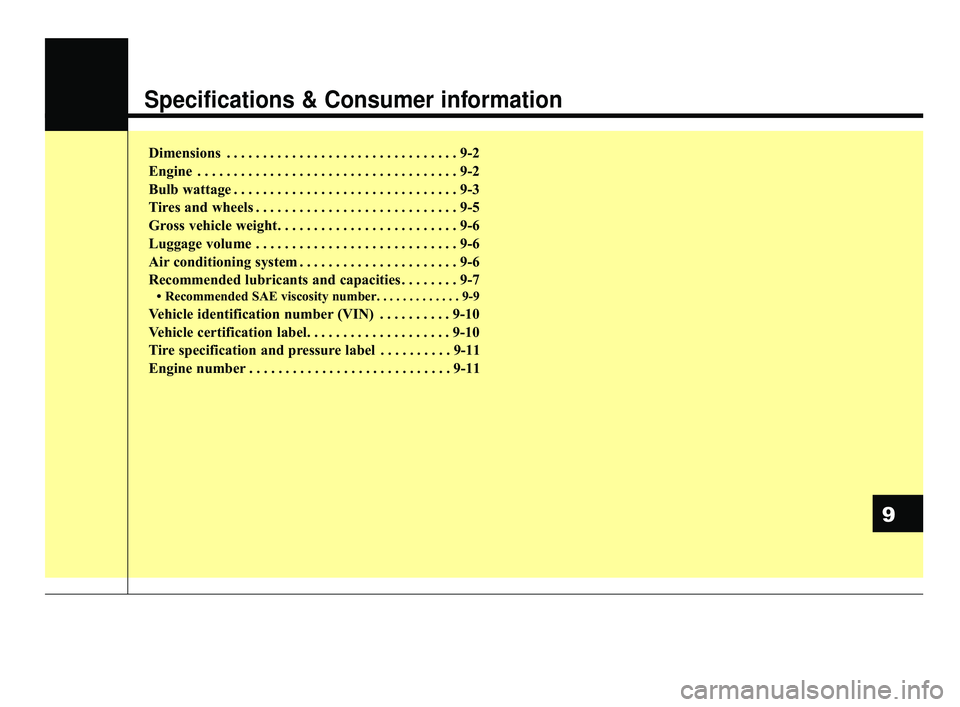
Dimensions . . . . . . . . . . . . . . . . . . . . . . . . . . . . . . . . 9-2
Engine . . . . . . . . . . . . . . . . . . . . . . . . . . . . . . . . . . . . \
9-2
Bulb wattage . . . . . . . . . . . . . . . . . . . . . . . . . . . . . . . 9-3
Tires and wheels . . . . . . . . . . . . . . . . . . . . . . . . . . . . 9-5
Gross vehicle weight. . . . . . . . . . . . . . . . . . . . . . . . . 9-6
Luggage volume . . . . . . . . . . . . . . . . . . . . . . . . . . . . 9-6
Air conditioning system . . . . . . . . . . . . . . . . . . . . . . 9-6
Recommended lubricants and capacities . . . . . . . . 9-7
• Recommended SAE viscosity number. . . . . . . . . . . . . 9-9
Vehicle identification number (VIN) . . . . . . . . . . 9-10
Vehicle certification label. . . . . . . . . . . . . . . . . . . . 9-10
Tire specification and pressure label . . . . . . . . . . 9-11
Engine number . . . . . . . . . . . . . . . . . . . . . . . . . . . . 9-11
9
Specifications & Consumer information
JF CAN (ENG) 9.qxp 8/29/2016 6:20 PM Page 1
Page 609 of 629
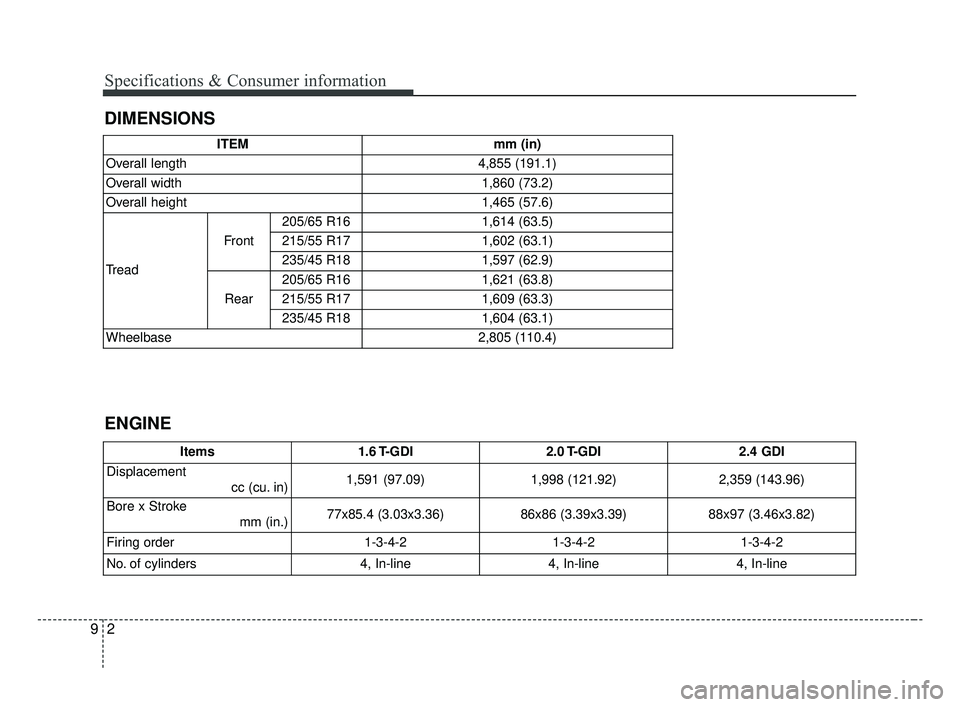
Specifications & Consumer information
29
DIMENSIONS
ENGINE
ITEMmm (in)
Overall length4,855 (191.1)
Overall width1,860 (73.2)
Overall height1,465 (57.6)
Tread
Front
205/65 R161,614 (63.5)
215/55 R171,602 (63.1)
235/45 R181,597 (62.9)
Rear
205/65 R161,621 (63.8)
215/55 R171,609 (63.3)
235/45 R181,604 (63.1)
Wheelbase2,805 (110.4)
Items 1.6 T-GDI2.0 T-GDI2.4 GDI
Displacementcc (cu. in)1,591 (97.09)1,998 (121.92) 2,359 (143.96)
Bore x Stroke mm (in.)77x85.4 (3.03x3.36)86x86 (3.39x3.39)88x97 (3.46x3.82)
Firing order1-3-4-21-3-4-21-3-4-2
No. of cylinders4, In-line4, In-line4, In-line
JF CAN (ENG) 9.qxp 8/29/2016 6:20 PM Page 2
Page 610 of 629
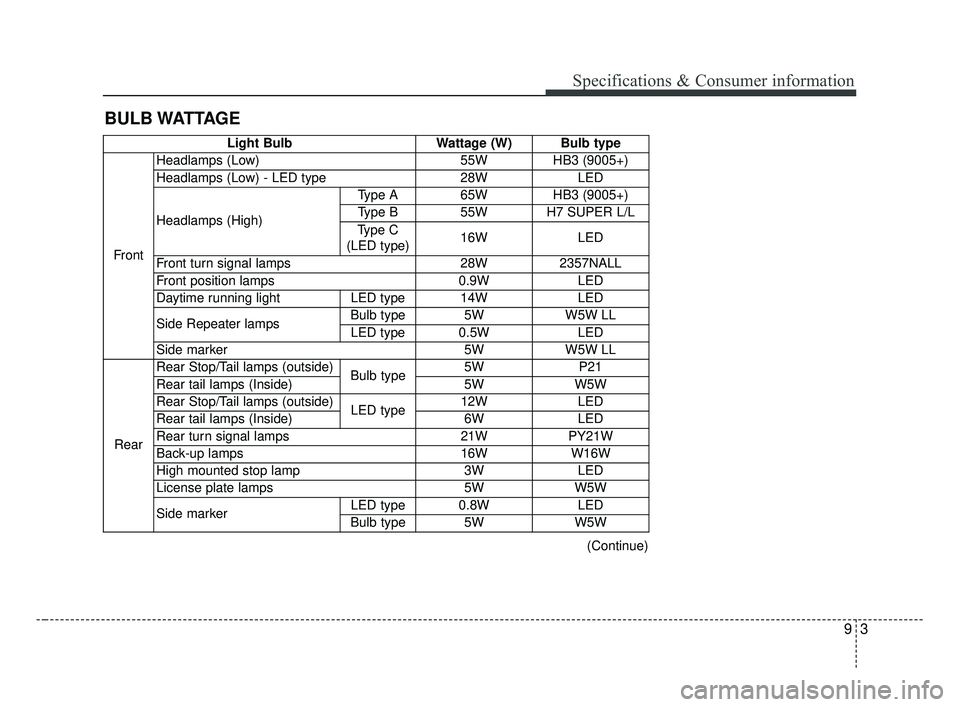
93
Specifications & Consumer information
BULB WATTAGE
Light BulbWattage (W) Bulb type
Front Headlamps (Low)
55W HB3 (9005+)
Headlamps (Low) - LED type 28WLED
Headlamps (High) Type A 65W HB3 (9005+)
Type B 55W H7 SUPER L/L
Type C
(LED type) 16W
LED
Front turn signal lamps 28W2357NALL
Front position lamps 0.9WLED
Daytime running light LED type 14W LED
Side Repeater lamps Bulb type 5W
W5W LL
LED type0.5WLED
Side marker5WW5W LL
Rear Rear Stop/Tail lamps (outside)
Bulb type5W P21
Rear tail lamps (Inside) 5W W5W
Rear Stop/Tail lamps (outside) LED type12W LED
Rear tail lamps (Inside) 6W LED
Rear turn signal lamps 21W PY21W
Back-up lamps 16W W16W
High mounted stop lamp 3W LED
License plate lamps 5W W5W
Side marker LED type 0.8W LED
Bulb type 5W W5W
(Continue)
JF CAN (ENG) 9.qxp 8/29/2016 6:20 PM Page 3